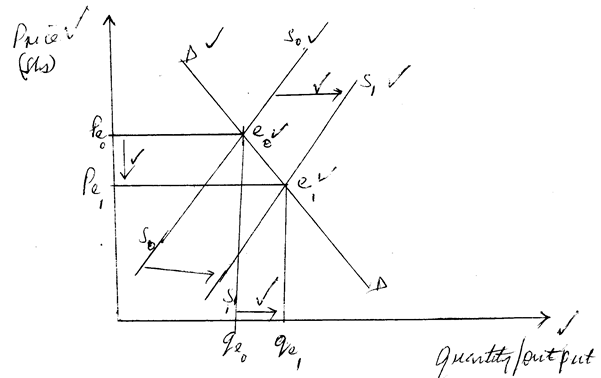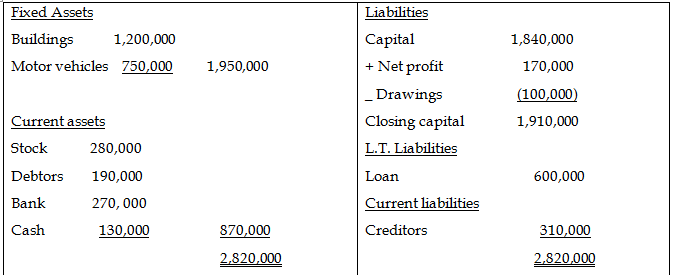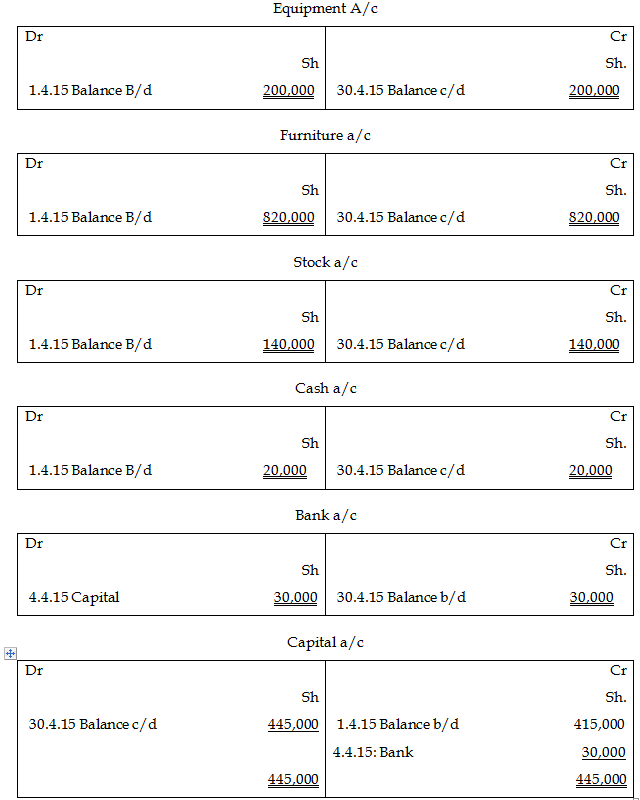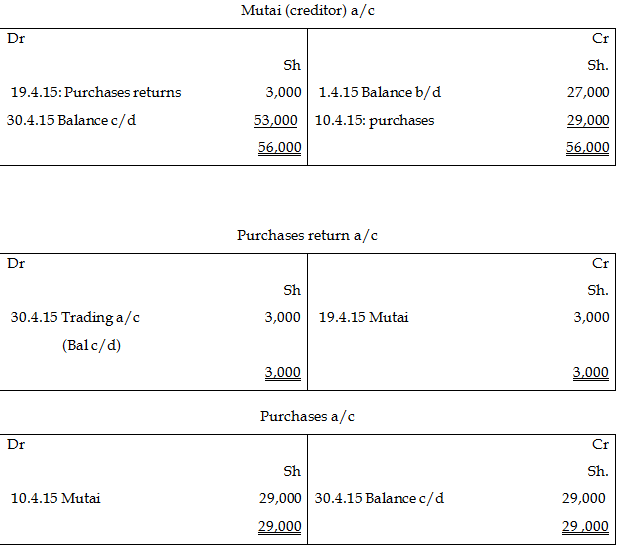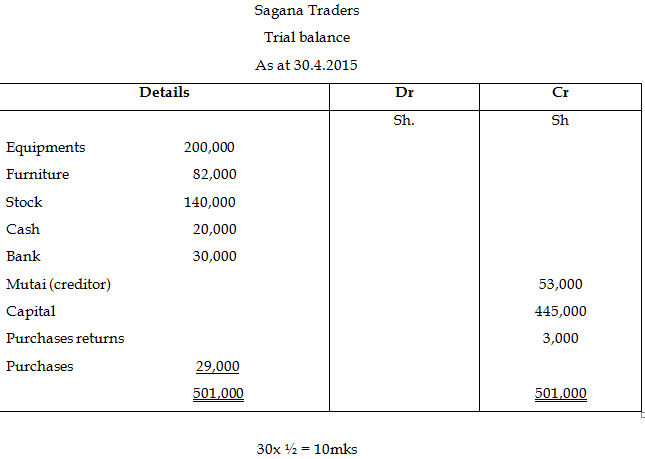-
- Functions of money
- Used / serves as a medium of exchange
Money may be exchanged for goods / services.
Can be used to buy goods / services as it is generally accepted as a medium of exchange - Measure of value – Value of goods / services can be computed or estimated or calculated using money
- Store of value – value of goods / services can be stored in form of money.
- Standard for deferred payments – money assist to conduct business on credit where payments is made later / at a future date
- Unit of account - Value of goods / services are recorded in terms of money 5 x 2 = 10mks
- Used / serves as a medium of exchange
-
Public Limited Company Partnership Minimum membership is 7 shareholders Minimum membership is 2 partners no maximum memebership maximum of 20 for business and 50 for professional shareholders have limited liability Parteners have unlimited liability Capital raised from sale of shares from general public Capital raised from memebers contribution Managed by a board of directors Managed by partners themselves / active partners Has perpetual continuity Has no perpetual continuity Shares can be quoted in stock exchange Shares can’t be quoted in stock exchange Owned by shareholders
Owned by partners Formed under company Act.
Formed under partnership Act
Mandatory by law public financial statements
Not mandatory by law to publish financial statements
- Functions of money
-
- Principles of taxation
- Equity – The tax should be charged according to ability to pay
- Certainty – The tax to be paid should be clearly defined / the tax payer should be informed about the rate of the tax / time of payment and amount to pay
- Convenience – Collection and payment of tax should not be cumbersome mode of payment and collection should be comfortable to tax payer and tax collector
- Economy – Administration cost of the tax should not exceed revenue from the tax / lower cost of collection compared to amount collected from the tax.
- Flexibility – It should be possible to revise / vary / change / adjust the tax easily to be in line with changing economic situations / prevailing conditions.
- Diversity – There should be a wide variety of taxes applied to yield enough / sufficient revenue / cover entire (taxable) population / suit different tax payers / ensure equity
- Simplicity – Tax system should be easy to understand / know how it works easy to apply.
- Elasticity – The tax revenue / collected should be able to respond to changes in national income / realist more income when economy is booming 5 x 2 = 10mks
- Measures to improve productivity of labour
- Provision of training / education / capacity building – To improve efficiency of the workers / improve their ability to perform their duties.
- Competitive / increased remuneration / salaries / wages / allowances – to be in line with similar businesses / to cover increased standards of living.
- Provision of efficient / modern tools / equipments / machinery / technology – That leads to improved quality of work / makes work easier / smooth.
- Improving working conditions – That makes working comfortable / enjoyable / workers to produce better goods / services.
- Improving working relations – Amongst the workers between workers and management
- Allowing workers to be part owners – by buying shared / ownership in the business / so as to create interest in the success of the business
- Giving incentive / rewards – That boost the work output / such as paid holidays, certificates / commendation letters, materials / financial rewards etc improved performance. 5 x 2 = 10mks
- Principles of taxation
-
- Effects of increase in supply to the equilibrium price and quantity of a commodity
Explanation- The supply curve shift to the right from S0 S0 to S1 S1
- The equilibrium price decrease from Pe0 to Pe
- The equilibrium quantity increase from qe0 to qe1 10 x 1 = 10mks
NB: for effects award ticks on the diagram or at the explanation part
- Causes of unfavourable balance of payments
- Reliance on primary products / raw materials / agricultural produce for export – Which fetch low prices in the international market hence lowering their export receipts
- Heavy / high importation of finished goods – Whose values are high / spend more on imports
- Rely on low levels of technology in production – Which produce poor quality exports lowering their demand / receipts
- Too much reliance on foreign borrowing / aid – Which are repaid with heavy interests i.e. loans
- Unfavourable world economic orders / policies / low bargaining power – hence end us earning less on experts and spending more on imports
- Decrease in demand for exports – hence lowering their country’s earnings
- Preference for goods from foreign countries (developed) in the belief that they are of better quality hence end up spending more on imports
- Political instability / insecurity – which may interfere with production activities lowering expert earnings.
- Poor governance / policies / corrupt practices – leading to capital flight / outflows 5 x 2 = 10mks
- Effects of increase in supply to the equilibrium price and quantity of a commodity
-
- Factors influencing choice of channel for distributing flowers
- Nature of the products / flowerers – flowers are perishable therefore need a short / direct channel to safeguard them from damage
- Cost of different channels of distribution should be considered and the cheapest channel used / affordable / cost effective channel is used
- Proximity of the market – if consumers are widespread long channels may be necessity to reach them
- Nature / tastes / preference of consumers – which might require the personal attention of the producer hence use of a shorter / direct channel
- Level of competition (stiff) – the producer will have to close to the consumer hence use a short / direct channel of distribution
- Availability of middlemen / agents / intermediaries – if there are no middlemen then a shorter direct channel is used and if available use long channel
- Government policy – where the government / law required a given cbhannel to be used then the producer will have to comply
- Size of the market / number of consumers – if it is small / few a short / direct channel will be used but if large / many a longer channel may be used 5 x 2 = 10mks
- Circumstances that would influence a producer to use wholesalers in distributing farm producer
- Where the producer requires / lack storage – for safety of goods / to facilitate continous production / save on storage cost
- Where goods required bulk breaking – thus relieving him on cost / burden of breaking bulk
- Where there is used to prepare goods for sale – before they reach the consumers
- Where goods need to be distributed for market is expensive – since the producer may not be able to cover / reach the whole market
- Where the producer would want to engage wholesalers to assist with advertising – so as to save on costs / reach a wider market.
- Where the producer requires ready cash / finance – since wholesalers can buy in cash / pay promptly / to raise working capital
- Where it is a government policy to distribute through wholesalers – then the producer would have no alternative
- Where the marketing risks are many / high the wholesaler can bear some of the risks 5 x 2 = 10mks
- Factors influencing choice of channel for distributing flowers
-
- Msafiri Traders
Balance Sheet
As at 31st December 2014- Mark- up = gross profit/Cost of sales
Where gross profit = Net profit + expenses
= 170,000 + 100,000
= 270,000
Cost of sales = opening +Purchases + carriage in – returns – closing outwards stock
= 230,000 + 900,000 + 150,000 – 50,000 – 280,000
= Kshs. 670,000
Therefore mark-up = gross profit/Cost of sales x 100 = 170,000/ 2,510,000x 100 = 40.298% 4 x ½ = 2mks - Return on capital employed = Net profit/Capital employed
Capital employed = Owners capital + L.T. Liabilities
= 1,910,000 + 600,000 = 2,500,000
Therefore Return on capital employed = 170,000/2,510,000 x 100 = 6.77% or 6.8% or 7.0% 4 x ½ = 2mks
- Mark- up = gross profit/Cost of sales
- Problems of a sole trader
- Lack of adequate capital – to operate and expand the business
- Lacks perpetual continuity – the life of the business depends on life of the owner i.e. death, insanity make business to collapse
- Unlimited liability – the liability of the owner is unlimited hence shoulders the business debts
- Suffers losses alone – sole trader bears all the losses alone i.e. no sharing of losses
- No division and specialization of labour – the sole trader do all the work / duties alone be no sharing of duties / work
- Limited management skills – the sole trader lack managerial skills required to operate the business
- Poor decision making – the sole trader does not consult anybody hence decisions made are not good i.e. no exchange of ideas 5 x 2 = 10mks
- Msafiri Traders
-
- Limitations of adoption of new technology
- Insufficient capital – to acquire and maintain the new technology
- Some technologies are advancing very fast requiring continuous updating which becomes expensive / costly
- Adoption of new technology may lead to lay-off of workers as they are replaced by new technology leading to increased unemployment problems
- New technology require hiring new staff or retraining existing ones – which is expensive / costly
- New technology increases costs of goods in the short-run
- Some technologies have side effects e.g. computers affects the eyesight of operator / employees
- Breakdown of some machines – may lead to loss or interruption of business operation
- Some technology may lead to environmental degradation e.g. disposal of waste which causes for measures which are expensive 5 x 2 = 10mks
- Ledger accounts
- Limitations of adoption of new technology
Download BUSINESS STUDIES PAPER 2 Marking Scheme - 2019 KCSE Prediction Answers Set 2.
Tap Here to Download for 50/-
Get on WhatsApp for 50/-
Why download?
- ✔ To read offline at any time.
- ✔ To Print at your convenience
- ✔ Share Easily with Friends / Students

